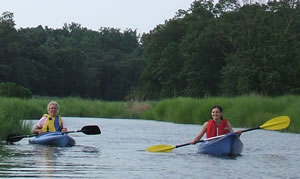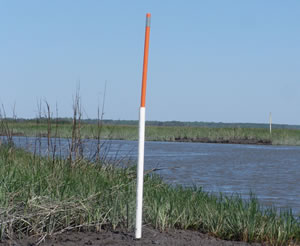Egg Island - Glades Paddling TrailsPrincipal Biologist, Bureau of Land Management April, 2012
BE PREPARED! Only you can ensure your safety by being prepared and knowing your limitations! If done safely, canoeing and kayaking are wonderful ways to experience the Delaware Bayshore. When you paddle, please follow the following tips. Water conditions vary from day to day and season to season. It is up to you to be prepared. PRIOR to LAUNCH
SAFETY TIPS
NOTICE!
WHAT to BRING
Hansey Creek Trail - Orange markers
Berrytown Trail - Yellow markers Each trail can be paddled as a loop or combined with other trails
for a destinational paddle. Each trail is marked with colored poles.
Poles are usually placed close enough to see the next pole in the distance. Stay alert at
creek intersections to avoid taking a wrong turn.
Each waterway is rated based on calm weather and water conditions,
appropriate level of paddling experience and length of trail. All
these trails require intermediate to advanced skills under calm conditions.
Understand that tidal waterways do not always fit into one category
of difficulty and may change due to fluctuations in the water levels
and rate of water flow due to tides, wind, lack of access points,
inclement weather, or other disturbances and obstructions.
The paddling times are estimates only (speed 2-3 mph). Wind,
tide and ability can have a tremendous affect on your actual time.
Leave plenty of time to complete your paddle during daylight.
Be aware that paddling up side creeks and guts on a falling tide
could leave you stranded in the mud. Crossing the marsh on foot is
difficult.
You will be paddling through the following areas:
The Glades Wildlife Refuge The Glades Refuge was once part of southern New Jersey's agricultural
and maritime economy. Crumbling foundations and fields reverting to
woodland are evidence of former agriculture. Farming, fishing and
crabbing remain popular activities outside of the preserve's boundaries.
The Glades is a haven for wildlife, providing year-round habitat
for many ducks, marsh birds, hawks, bald eagles, and various upland
birds as well as fox, deer, otter, and other mammals. The area is
also an important wintering place for snow geese and a crucial habitat
for migratory shorebirds in the fall and spring. Look for these creatures
as you paddle.
Egg Island WMA Look for rails, mussels and fiddler crabs at the edge of the water,
and egrets and herons in the marsh. Bald eagles, northern harriers,
red-tailed hawks, and many species of terns and gulls may be seen
while paddling. Thousands of snow geese and other waterfowl frequent
the marsh in fall and winter.
PSEG Wetland Restoration Site A paddle through this area at low tide in the spring or fall will
reveal thousands of shorebirds feeding on the mudflats. This is also
a favorite feeding and resting spot for teal and other waterfowl.
Diamondback terrapins bask on the shore.
Look for rails, raccoons, mussels and fiddler crabs at the edge
of the water, and egrets and herons in the marsh. Bald eagles, northern
harriers, red-tailed hawks, and many species of shorebirds, terns
and gulls fill the sky. Look for these creatures as you paddle.
DIRECTIONS
Clicking on the name of the launch point below will open a Google
Maps window or tab showing the approximate location.
Beaver
Dam Boat Rentals |
||||
|
||
|
|
||
|
||
| |
||


